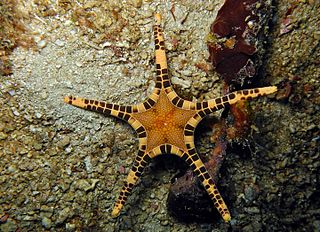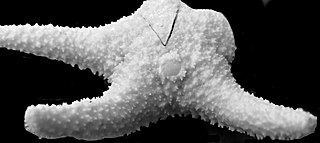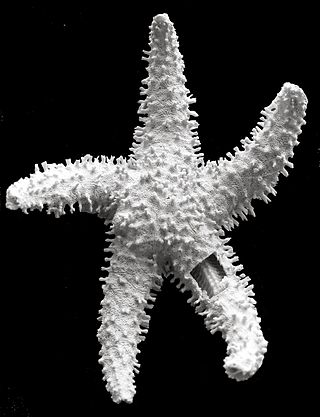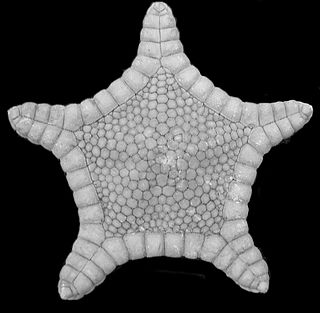
Starfish or sea stars are star-shaped echinoderms belonging to the class Asteroidea. Common usage frequently finds these names being also applied to ophiuroids, which are correctly referred to as brittle stars or basket stars. Starfish are also known as asteroids due to being in the class Asteroidea. About 1,900 species of starfish live on the seabed in all the world's oceans, from warm, tropical zones to frigid, polar regions. They are found from the intertidal zone down to abyssal depths, at 6,000 m (20,000 ft) below the surface.

Kiwa is a genus of marine decapods living at deep-sea hydrothermal vents and cold seeps. The animals are commonly referred to as "yeti lobsters" or "yeti crabs”, after the legendary yeti, because of their "hairy" or bristly appearance. The genus is placed in its own family, Kiwaidae, in the superfamily Chirostyloidea. The genus Kiwa is named after the god of shellfish in Polynesian mythology.

The Forcipulatida are an order of sea stars, containing three families and 49 genera.

Enypniastes is a genus of deep-sea sea cucumber. It is monotypic, being represented by the single species Enypniastes eximia. Due to its unique appearance, the species has been dubbed the headless chicken fish, headless chicken monster, and the Spanish dancer. It is also known as the swimming sea cucumber, and some are called the pink see-through fantasia.

Cidaridae is a family of sea urchins in the order Cidaroida.

Kiwa tyleri, the Hoff crab, is a species of deep-sea squat lobster in the family Kiwaidae, which lives on hydrothermal vents near Antarctica. The crustacean was given its English nickname in 2010 by UK deep-sea scientists aboard the RRS James Cook, owing to resemblance between its dense covering of setae on the ventral surface of the exoskeleton and the hairy chest of the actor David Hasselhoff. The 2010 expedition to explore hydrothermal vents on the East Scotia Ridge was the second of three expeditions to the Southern Ocean by the UK led research consortium, ChEsSo.

Hippasteria is one of 70 genera of sea stars in the diverse family Goniasteridae.

Fromia is a genus of starfish belonging to the family Goniasteridae.

Iconaster longimanus, the icon star or double star, is a species of starfish in the family Goniasteridae. It is found in the west and central Indo-Pacific Ocean. The genus name comes from the Greek eikon, meaning portrait or image and possibly referring to the way the marginal plates frame the disc, and aster, meaning star. The specific name comes from the Latin longus manus and refers to the long, slender arms.
Astropecten latespinosus is a species of starfish in the family Astropectinidae. It is one of the commonest starfish in the seas around Japan. The name in Japanese is hira momiji, "hira" meaning flattened and "momiji" meaning maple leaves tinged with bright red, a name given to certain starfish which resemble maple leaves in form.
Trophodiscus almus is a species of starfish in the family Astropectinidae. It is found in fairly deep waters in the Sea of Okhotsk, the Sea of Japan and around the Japanese island of Hokkaido. It is very unusual among starfish in that it broods its young on its upper surface. Its common name in Japanese is "Komochi-momiji".

Bathyporania ascendens is a species of starfish in the family Poraniidae, and the only species of the genus Bathyporania. It is native to the Pacific Ocean and is found in deep water off the coast of North America.

Clavaporania fitchorum is a species of starfish in the family Poraniidae. It is the only known species of the genus Clavaporania. It is native to the South Pacific Ocean and is found in deep water off the coast of Australia.

Evoplosoma is a genus of deep-sea sea star in the family Goniasteridae.

Astroceramus is a genus of abyssal sea stars in the family Goniasteridae.

Apollonaster is a genus of abyssal sea stars in the family Goniasteridae. They can be identified by their bare abactinal plate surfaces and multiple accessory granule rows on their abactinal plates. To date, Apollonaster has been found in the tropical Atlantic region and Hawaiian Islands region oceans, with no other locations or species being known as of 2015.

Hippasteria muscipula is one of twelve species of deep-sea sea star in the genus Hippasteria, which is in the family Goniasteridae.
Paulasterias mcclaini is a species of starfish in the family Paulasteriidae. It is found in deep water at hydrothermal vents.

Asterodiscides truncatus, the firebrick starfish, is a species of five-armed starfish in the family Asterodiscididae. It is native to eastern and southern Australia, the Norfolk Ridge and the Kermadec Islands of New Zealand.
Kemp Caldera and Kemp Seamount form a submarine volcano south of the South Sandwich Islands, in a region where several seamounts are located. The seamount rises to a depth of 80 metres (260 ft) below sea level; the caldera has a diameter of 8.3 by 6.5 kilometres and reaches a depth of 1,600 metres (5,200 ft). The caldera contains several Hydrothermal vents, including white smokers and diffuse venting areas, which are host to chemolithotrophic ecological communities. The seamount and caldera, which were discovered by seafloor mapping in 2009, are part of the South Georgia and the South Sandwich Islands Marine Protected Area.













